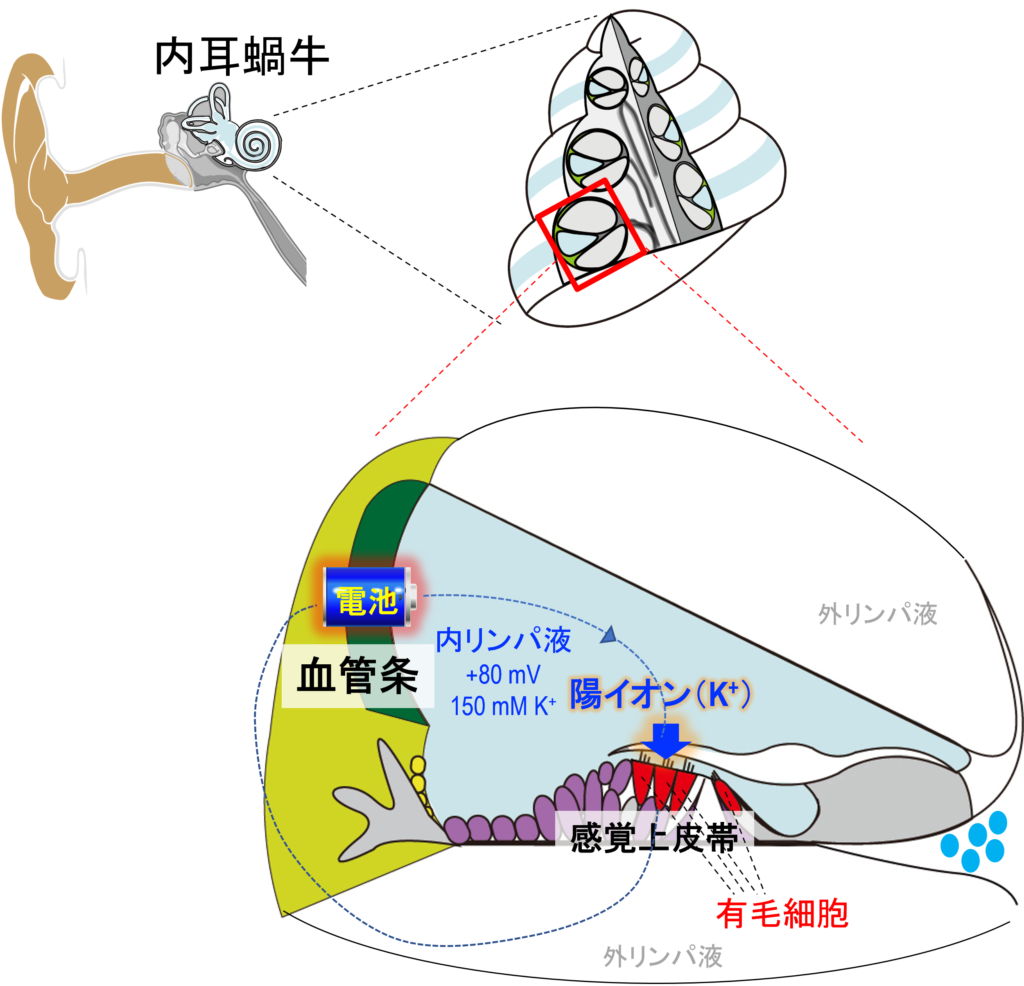内耳と難聴の研究
私たちは、内耳蝸牛に係る研究として、❶感覚上皮帯のナノ振動、❷生体電池の仕組み、の2つを進めています。
❷生体電池の仕組み
【研究の概略】
図1は、3つの管から成る蝸牛の断面図です。上下二つの管は、通常の細胞外液や血液と類似の「外リンパ液」を含んでいます。一方、中央の管には、「内リンパ液」と呼ばれる特殊な体液が満たされています。これは、細胞外液であるにも関わらず、150 mMの高K+(カリウムイオン)と2~5 mMの低Na+(ナトリウムイオン)を含みます。まるで、細胞内の環境のようです。 しかも、内リンパ液は、外リンパ液を基準とすると、常に+80 ~ +100 mVの高電位を示します。このような特殊な電位・イオン環境は、有毛細胞の鋭敏な働きや聴覚の高い感受性に必須です。特に高電位は重要であり、破綻すると難聴が起こります。


以前より、内リンパ液の環境は、蝸牛の側壁にある細胞シート層「血管条」に備わる生体電池により維持されていると考えられてきました。さらに、この電池と有毛細胞が電気的につながっており、K+を循環させていること、さらにこの回路が内リンパ液の高電位や高K+の成立に重要な役割を果たしていると指摘されてきました。
しかし、これらの仕組みの詳細は不明な点が多かったため、私たちはその解明を目指して長年研究を続けてきました。K+循環を支える一方向性のイオン輸送は、内層・外層の2層から構成される血管条により駆動されると想定されています。他グループの研究成果も合わせると、(1)血管条ではおおよそ図2に示すようなイオンチャネル・トランスポータが機能共役することでK+が蝸牛全体を円滑に循環すること、(2)血管条には二つの“K+濃淡電池”が直列につながっており、これらがK+循環によって綿密に調節されること、(3)以上の(1)と(2)の結果により、内リンパ液に高電位が現れることが、徐々に分かってきました(成果5-12)。事実、血管条から距離的に離れた有毛細胞を音刺激すると、蝸牛のK+循環が影響され、血管条の電池の起電力が変化しました(成果1)。 また、このK+循環に関わる血管条の重要要素を光遺伝学の手法で障害させると、突発性難聴のように瞬時に聴力低下が誘引される病態が再現できました(成果4)。
【実験手法】
実験装置の外見などは、計測機器 のページをご覧ください。
⑴ 分子生物学的手法・組織学的手法:K+循環に関与するチャネルやトランスポータを分子同定し、その局在を知るために使います(成果4, 5, 13)。
⑵ 網羅的解析:HPLCやLC-MS/MSなどの最新機器を使い、K+循環に関与する分子を網羅的に同定しています。大阪大学大学院医学系研究科の金井好克教授・永森收志准教授(現 慈恵医科大学)などの先生方との共同研究です(成果2, 14)。
(3)イオン電極法:K+循環は、血管条のイオン濃度を制御することで電池の起電力および内リンパ液の高電位を維持します。従って、血管条の細胞内外のK+濃度動態を調べることは、とても重要です。 私たちは、局所のK+濃度と電位を同時にモニタリングする「イオン電極」を、in vivo計測に活用しています。現在、蝸牛を対象にこの技術を駆使できるのは、世界でも恐らくわたしたちのみです(成果5-11)。
⑷ コンピュータシミュレーション:生命現象には、実験では測れないパラメータがあります。 例えば、本研究に関しては、チャネルやトランスポータを介した各イオンの流れを直接的に捉えることはできません。計算科学は、理論的背景に立って、この問題を解決してくれます。わたしたちは、側壁に分布するチャネルやトランスポータの働きに基づき数式を立て、有毛細胞のイオン流と統合した数理モデル「Nin-Hibino-Kurachi(NHK)モデル」を2012年に発表しました(成果10)。詳しくは、計測装置のコーナーをご覧ください。その後の実験結果に基づき、最近、モデルを更新し(fi-NHKモデル;ソースコード)(成果5)、有毛細胞の音刺激時の反応を解析しました(成果1)。引き続き、疾患時も含めた多彩な局面を対象にモデルを改良・活用していく予定です。
この研究に関する主な成果
(1) Zhang Q*, Ota T*, Yoshida T, Ino D, Sato MP, Doi K, Horii A, Nin F#, Hibino H# (2021). Electrochemical properties of the non-excitable tissue stria vascularis of the mammalian cochlea are sensitive to sounds. The Journal of Physiology 599(19):4497-4516. [*: equal contributors]
(2) Nonomura Y, Sawamura S, Hanzawa K, Nishikaze T, Sekiya S, Higuchi T, Nin F, Uetsuka S, Inohara H, Okuda S, Miyoshi E, Horii A, Takahashi S, Natsuka S, Hibino H. Characterisation of N-glycans in the epithelial-like tissue of the rat cochlea. Scientific Reports, (2019), 9, Article number:1551.
(3) Watabe T, Xu M, Watanabe M, Nabekura J, Higuchi T, Hori K, Sato MP, Nin F, Hibino H, Ogawa K, Masuda M, Tanaka KF. Time-controllable Nkcc1 knockdown replicates reversible hearing loss in postnatal mice. Scientific Reports, (2017), 7, Article number:13605.
(4) Sato MP, Higuchi T, Nin F, Ogata G, Sawamura S, Yoshida T, Ota T, Hori K, Komune S, Uetsuka S, Choi S, Masuda M, Watabe T, Kanzaki S, Ogawa K, Inohara H, Sakamoto S, Takebayashi H, Doi K, Tanaka KF, Hibino H. Hearing loss controlled by optogenetic stimulation of nonexcitable nonglial cells in the cochlea of the inner ear. Frontiers in Molecular Neuroscience, (2017), 10(300): 1-16.
(5) Nin F, Yoshida T, Murakami S, Ogata G, Uetsuka S, Choi S, Doi K, Sawamura S, Inohara H, Komune S, Kurachi Y, Hibino H. Computer modeling defines the system driving a constant current crucial for homeostasis in the mammalian cochlea by integrating unique ion transports. npj Systems Biology and Applications, (2017), 3, Article number:24.
(6) Yoshida T, Nin F, Murakami S, Ogata G, Uetsuka S, Choi S, Nakagawa T, Inohara H, Komune S, Kurachi Y, Hibino H. The unique ion permeability profile of cochlear fibrocytes and its contribution to establishing their positive resting membrane potential. Pflügers Archiv - European Journal of Physiology, (2016), 468(9): 1609-1619.
(7) Nin F, Yoshida T, Sawamura S, Ogata G, Ota T, Higuchi T, Murakami S, Doi K, Kurachi Y, Hibino H. The unique electrical properties in an extracellular fluid of the mammalian cochlea; their functional roles, homeostatic processes, and pathological significance. Pflügers Archiv - European Journal of Physiology, (2016), 468(10): 1637-1649.
(8) Yoshida T, Nin F, Ogata G, Uetsuka S, Kitahara T, Inohara H, Akazawa K, Komune S, Kurachi Y, Hibino H. NKCCs in the fibrocytes of the spiral ligament are silent on the unidirectional K+-transport that controls the electrochemical properties in the mammalian cochlea. Pflügers Archiv - European Journal of Physiology, (2015), 467(7): 1577-1589.
(9) Adachi N, Yoshida T, Nin F, Ogata G, Yamaguchi S, Suzuki T, Komune S, Hisa Y, Hibino H#, Kurachi Y#. The mechanism underlying maintenance of the endocochlear potential by the K+-transport system in the fibrocytes of the inner ear. Journal of Physiology (London), (2013), 591(18): 4459-4472. [#: equal corresponding authors]
(10) Nin F, Hibino H#, Murakami S, Suzuki T, Hisa Y, Kurachi Y#. A computational model of a circulation current that controls electrochemical properties in the mammalian cochlea. Proceedings of National Academy Sciences of the United States of America, (2012), 109(23): 9191-9196. [#: equal corresponding authors]
(11) Nin F*, Hibino H*, Doi K, Suzuki T, Hisa Y, Kurachi Y. The endocochlear potential depends on two K+ diffusion potentials and an electrical barrier in the stria vascularis of the inner ear. Proceedings of National Academy Sciences of the United States of America, (2008), 105(5):1751-1756. [*: equal contributors]
(12) Hibino H, Kurachi Y. Molecular and physiological bases of the K+ circulation in the mammalian inner ear. Physiology (Bethesda), (2006), 21:336-345.
(13) Hibino H, Horio Y, Inanobe A, Doi K, Ito M, Yamada M, Gotow T, Uchiyama Y, Kawamura M, Kubo T, Kurachi Y. An ATP-dependent inwardly rectifying potassium channel, KAB-2 (Kir4.1), in cochlear stria vascularis of inner ear: its specific subcellular localization and correlation with the formation of endocochlear potential. Journal of Neuroscience, (1997), 17(12):4711-4721.
(14) Uetsuka S*, Ogata G*, Nagamori S*, Isozumi N, Nin F, Yoshida T, Komune S, Kitahara T, Kikkawa Y, Inohara H, Kanai Y, Hibino H. Molecular architecture of the stria vascularis membrane transport system, which is essential for physiological function of the mammalian cochlea. European Journal of Neuroscience, (2015), 42: 1984-2002. [*: equal contributors]
(15) Fukuda M, Okanishi H, Ino D, Ono K, Ota T, Wakai E, Sato T, Ohta Y, Kikkawa Y, Inohara H, Kanai Y, Hibino H (2024). Protein profile of mouse endolymph suggests a role in controlling cochlear homeostasis. iScience, in press.






